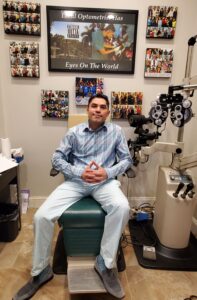
Dr. Mena in one one of his exam rooms. He makes a point of educating patients about the important role nutrition plays in helping to prevent, and slowing, the progression of AMD.
Working toward better outcomes for your AMD patients
By Vittorio Mena, OD, MS
March 27, 2024
Age-related macular degeneration (AMD) shows no sign of slowing down in its prevalence. According to the American Macular Degeneration Foundation and the Centers for Disease Control and Prevention, there are nearly “20 million Americans aged 40 and older that have been diagnosed with some type of macular degeneration.”1 Of those 20 million, “1.49 million are living with late stages that are vision threatening.” 1
Here is how I help patients by educating them on the importance of nutrition, and by prescribing supplements for an extra protective boost against AMD.
Who Needs to Know About Connection Between AMD & Nutrition?
Any patient with a risk factor for AMD, such as trouble seeing at night, a family history, or status as a smoker, should be educated on the role nutrition plays in reducing risk.
Many doctors sadly will wait for a problem to arise before taking action, or will simply monitor the disease. This reactive approach can potentially cause harm to patients down the road.
I let my patients know that eating leafy green vegetables, and minimizing fried, fatty foods, can bring the zeaxanthin and lutein into their bodies that their eyes need. It may be difficult, though, for patients to ingest enough of those vegetables for their eyes to get what they need. For that reason, I talk about adding supplements, in addition to improving eating habits, as a way to not only decrease risk of AMD, but to also improve the contrast sensitivity of their vision.
If the patient already has signs of drusen, or other concerning signs of advanced AMD, I explain how paying attention to nutrition and taking a supplement can slow down the progression of the disease, or dare I say, even prevent it from happening in the first place.
In addition, I educate patients on the importance of proper sleep.
Selling Supplements in Your Office or Through Affiliate Program Online
About 20 percent (one out of every five) of my patients with no current disease state or with family history are currently purchasing supplements, whether it is through our office or from the supermarkets/online. Eighty percent of my patients with AMD will start taking a supplement.
I sell the supplements in our office and on our website. I prefer patients to buy them directly from us, as they might end up buying a different brand from the one I prescribed if they were to buy it on their own elsewhere.
The cost to my practice is $40 per bottle. If you retail the bottle at $90, then each bottle would generate a profit of $50. Since that is just one bottle, and the goal is to sell a year supply for each patient, that would be a profit of $200 per patient who opts for a year supply.
Other Articles to Explore
If you get your supplement inventory through a buying group, your profit margin will be about $5-$10 more per bottle. Let’s pretend you sell a year supply to five patients a week, and you continue doing this for 50 weeks (since you take two weeks off for vacation). The total profit to the practice would be $50,000 annually.
Co-Manage AMD Patients as Needed
Since I practice in New Jersey, next door to New York City, I have many retina specialists (minimum 10) nearby, so I have the luxury of being able to send a patient to a specialist who is close to their home.
The gold standard for detecting any issues with the macula is via imaging with an OCT. This technology can detect a problem before it shows itself in a fundus photo.
When necessary, I refer the patient to a retina specialist for a second opinion. I then follow-up with that patient, calling them back to my office one month after they see the retina specialist.
It’s Too Easy to Miss Early AMD
There are more patients living with AMD than glaucoma in the U.S.2 As optometrists, we are always treating and monitoring glaucoma in practice to make sure our patients do not lose vision. The same should apply for AMD.
AMD is too often missed in practices when the disease state is still in its earliest stages. It is not until we notice drusen in the fundus photo, or with 90/BIO, that we start to take action.
If you have an OCT in your office, and patients complain of glare, run an OCT of the macula. You never know what you might pick up!
References
2. https://www.healthline.com/health/macular-degeneration-vs-glaucoma
I am delighted to announce that Vittorio Mena OD, MS, is joining us as a monthly columnist for ROB. A dedicated optometrist with a keen interest in sports vision, nutrition and personal finances, I believe his insights will offer a unique perspective for all our readers. Welcome aboard, Dr. Mena! —ROB Professional Editor Laurie Sorrenson, OD, FAAO
 Vittorio Mena OD, MS, is the sports vision director with Optical Academy. Dr. Mena is also an Optometric Financial Planner, with Series 6 and 63 investment licenses and Series 2-14 life and variable annuity licenses. To contact him: menavitt@gmail.com
Vittorio Mena OD, MS, is the sports vision director with Optical Academy. Dr. Mena is also an Optometric Financial Planner, with Series 6 and 63 investment licenses and Series 2-14 life and variable annuity licenses. To contact him: menavitt@gmail.com



























